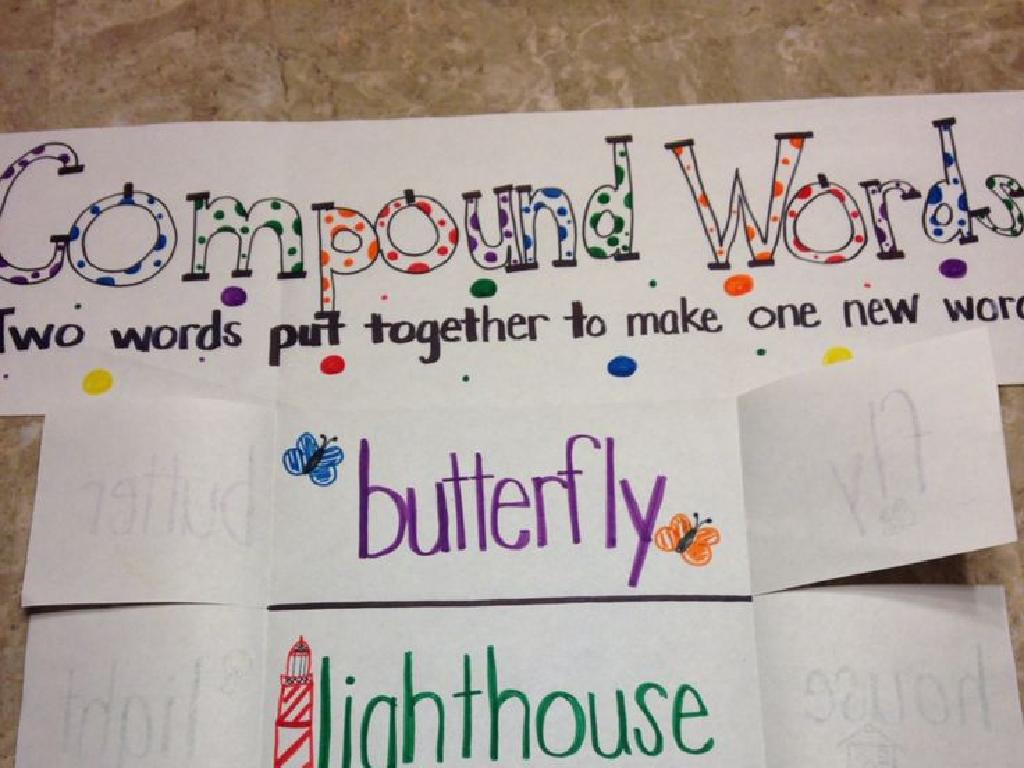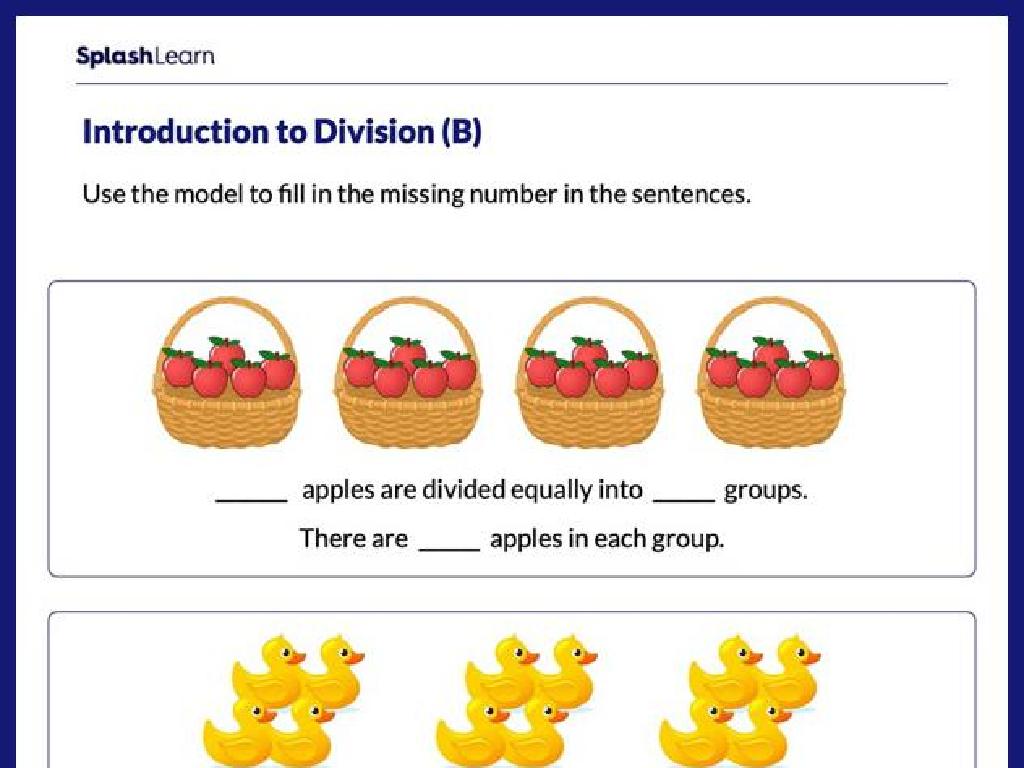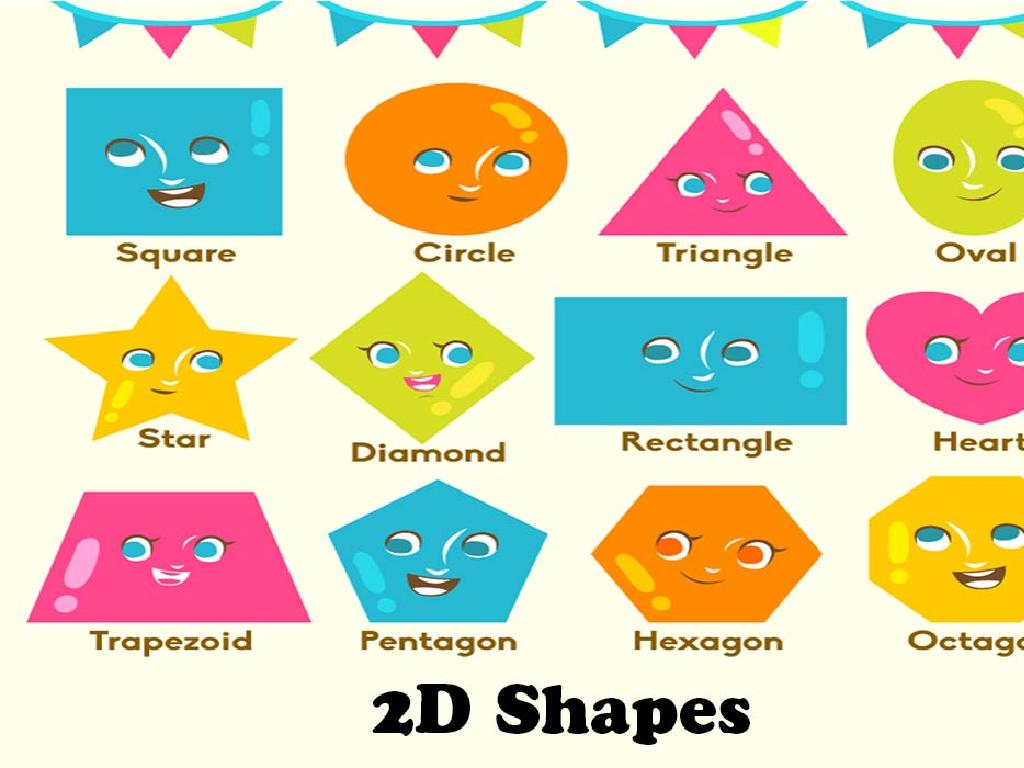Complete The Word With The Correct R-Controlled Vowel: Ar, Er, Ir, Or, Ur
Subject: Language arts
Grade: Second grade
Topic: R-Controlled Vowels
Please LOG IN to download the presentation. Access is available to registered users only.
View More Content
Exploring R-Controlled Vowels
– Discover r-controlled vowels
– Vowels that change sound when followed by ‘R’
– Learn the ‘bossy R’ effect
– ‘R’ changes how the vowel sounds
– See examples: ar, er, ir, or, ur
– car, fern, bird, fork, and fur
– Practice with fun words
– We’ll play a game to find the right vowel sound!
|
This slide introduces the concept of r-controlled vowels to second graders, which is a fundamental part of their phonics education. Explain that when a vowel is followed by an ‘R’, it creates a unique sound. This is often referred to as the ‘bossy R’ because the ‘R’ takes over and changes the vowel sound. Provide clear examples for each r-controlled vowel sound and encourage the students to repeat after you. For the practice activity, consider a matching game where students match words to the correct r-controlled vowel sound or a fill-in-the-blank exercise with words missing the r-controlled vowel. This will help reinforce their understanding through application.
Meet the R-Controlled Vowels
– Vowels change with ‘r’ after them
– ‘r’ takes control of the vowel sound
– Explore each r-controlled vowel
– ‘ar’, ‘er’, ‘ir’, ‘or’, ‘ur’ are r-controlled vowels
– Examples: ‘ar’ as in ‘car’, ‘er’ in ‘her’
– ‘ir’ as in ‘bird’, ‘or’ as in ‘corn’, ‘ur’ as in ‘fur’
|
This slide introduces the concept of r-controlled vowels to second-grade students. Explain that when a vowel is followed by an ‘r’, it doesn’t sound the same as it usually does; the ‘r’ changes the vowel sound. This is a key concept in phonics that helps with reading and pronunciation. Provide examples for each r-controlled vowel and encourage students to come up with more examples on their own. Use visual aids like pictures of the words or written words to help students connect the sounds to the letters. Practice pronouncing the sounds clearly and have the students repeat after you to ensure they grasp the different sounds made by r-controlled vowels.
The Pirate Sound: ‘ar’
– ‘ar’ sounds like a pirate’s ‘arr!’
– Practice saying ‘car’
– ‘Car’ has the ‘ar’ sound, just like ‘star’ and ‘far’
– Hunt for ‘ar’ sound words
– Look in books, signs, or at home for ‘ar’ words
– Share words with the class
– We’ll make a treasure map of words together in class
|
This slide introduces the ‘ar’ r-controlled vowel sound, often associated with the way pirates speak (‘arr!’). Start by having the students practice the sound with the word ‘car’. Then, encourage them to find more words that contain the ‘ar’ sound as a fun ‘word hunt’ activity. They can look for these words in their favorite books, on signs, or even around their home. The goal is to make a list of ‘ar’ words to share with the class. In the next class, compile all the words the students found into a ‘treasure map’ of ‘ar’ words, reinforcing the sound and how it appears in different words. This interactive activity will help solidify their understanding of the ‘ar’ sound in a memorable way.
The Sound of ‘er’: R-Controlled Vowels
– ‘er’ sounds like ‘teacher’
– Compare ‘her’ and ‘flower’
– Do ‘her’ and ‘flower’ sound the same? Listen closely!
– Practice with ‘er’ words
– Try ‘fern’, ‘winter’, and ‘sister’
|
This slide focuses on the ‘er’ sound in r-controlled vowels, which is a key concept for second graders learning to read and spell. Start by explaining that the ‘er’ sound can be found in many words, and it’s the same sound they hear in ‘teacher’. Have students practice saying ‘her’ and ‘flower’ to notice the ‘er’ sound. Encourage them to listen for the similarity in the sound, even though the words are spelled differently. Provide additional examples like ‘fern’, ‘winter’, and ‘sister’ for the students to practice with. The goal is for students to recognize and pronounce the ‘er’ sound confidently. During the next class, you can have a fun activity where students find and share words from their favorite books that contain the ‘er’ sound.
The Sound of ‘ir’: Like a Bird!
– ‘ir’ makes the sound in ‘bird’
– It’s the same ‘ir’ you hear in ‘stir’ and ‘whirl’
– ‘ir’ sounds like ‘er’ and ‘ur’
– These sounds are often interchangeable
– Practice with the word ‘shirt’
– Say ‘shirt’ together and listen to the ‘ir’
– Listen for ‘ir’ in words
|
This slide focuses on the ‘ir’ r-controlled vowel sound, which is the same sound found in words like ‘bird’, ‘stir’, and ‘whirl’. Emphasize to students that ‘ir’ can sound similar to ‘er’ and ‘ur’, and this can be seen in words like ‘her’ and ‘fur’. Have the class practice saying the word ‘shirt’ aloud, focusing on the ‘ir’ sound. Encourage them to listen for the ‘ir’ sound in other words and to understand that even though ‘ir’, ‘er’, and ‘ur’ can sound the same, they are used in different words. This will help them recognize patterns in spelling and pronunciation. For the activity, students can find other words with the ‘ir’ sound and practice writing sentences using those words.
The Sound of ‘or’: R-Controlled Vowels
– ‘or’ sounds like in ‘orange’
– Hear ‘or’ in the word ‘door’
– List words with the ‘or’ sound
– Examples: ‘fork’, ‘storm’, ‘short’
– Practice spelling ‘or’ words
– Use ‘or’ words in sentences
|
This slide focuses on the ‘or’ sound, which is an r-controlled vowel. R-controlled vowels are a vital part of phonics instruction in the second grade. Start by explaining that the ‘or’ sound can be found in many words, and it’s the combination of the letter ‘o’ followed by ‘r’ that changes the sound. Use words like ‘orange’ and ‘door’ to illustrate this sound. Then, engage the students in a brainstorming activity to list other words that contain the ‘or’ sound. Encourage them to practice spelling these words and to use them in sentences to reinforce their understanding. This activity will help students recognize and pronounce the ‘or’ sound, which is essential for their reading and spelling skills.
The Sound of ‘ur’: Exploring R-Controlled Vowels
– ‘ur’ sound in words
– ‘ur’ in ‘burger’, ‘fur’, ‘nurse’
– The ‘ur’ sound can be heard in words like ‘burger’, ‘fur’, and ‘nurse’.
– Discover more ‘ur’ words
– Think of words that have the ‘ur’ sound and write them down.
– Practice spelling with ‘ur’
– We’ll practice spelling new ‘ur’ words together.
|
This slide is focused on teaching second-grade students about the ‘ur’ sound in r-controlled vowels. Start by explaining that the ‘ur’ sound can be found in many words, and it’s the same sound in ‘burger’, ‘fur’, and ‘nurse’. Encourage students to think of other words that contain the ‘ur’ sound and write them down for practice. This will help them recognize patterns in spelling and pronunciation. During the next class, review the words they’ve found and practice spelling them together, reinforcing their understanding of the ‘ur’ sound in different words.
R-Controlled Vowel Matching Game
– Match words to r-controlled vowels
– Complete words with ar, er, ir, or, ur
– For example: st_r (star), teach_r (teacher)
– Team up for the matching game
– Get ready to have fun with words!
|
This slide introduces a matching game to help students learn r-controlled vowels. The activity is designed to be interactive and fun, encouraging students to work together to find the correct r-controlled vowel that completes each word. Before starting the game, review what r-controlled vowels are and provide examples. During the game, monitor the students’ progress and offer guidance as needed. Possible variations of the game could include a timed challenge, team competition, or pairing up students to promote cooperative learning. The goal is to reinforce their understanding of r-controlled vowels in a playful and engaging way.
R-Controlled Vowels: Fill in the Blanks
– Understand ‘ar’, ‘er’, ‘ir’, ‘or’, ‘ur’
– Example: c_r becomes ‘car’
– ‘ar’ makes the sound like in ‘star’
– Your turn to find and complete words
– Look for missing ‘ar’, ‘er’, ‘ir’, ‘or’, ‘ur’ in words
– Let’s practice with more examples
– We’ll do this together as a fun activity
|
This slide is an interactive class activity designed to help students practice using r-controlled vowels. Start by explaining what r-controlled vowels are and how they change the sound of the word. Use the example provided to show how the missing vowel sound is filled in. Then, encourage students to apply this knowledge by finding and completing words on their own or in small groups. Provide a list of incomplete words for them to work on, and be ready to assist if they struggle. Possible words include ‘b_rd’, ‘h_rse’, ‘n_rse’, ‘t_rn’. This activity will reinforce their understanding of r-controlled vowels in a fun and engaging way.
R-Controlled Vowel Hunt Activity
– Let’s hunt for words in class!
– Find objects with r-controlled vowels
– Look for ar, er, ir, or, ur in names
– Team up with a buddy for the hunt
– List all the r-vowel words you find
|
This class activity is designed to make learning about r-controlled vowels interactive and fun. Have the students work in pairs to search the classroom for objects that contain r-controlled vowels (ar, er, ir, or, ur) in their names. Examples could include ‘chart’, ‘fern’, ‘bird’, ‘cork’, ‘fur’. Encourage them to write down each word they find. After the hunt, regroup and discuss the words they discovered, emphasizing the pronunciation and spelling of the r-controlled vowels. This will help reinforce their understanding of the concept through practical application. Prepare a list of objects in the classroom beforehand to ensure there are enough examples for the students to find.
Mastering R-Controlled Vowels
– Congratulations on learning r-controlled vowels!
– ‘r’ alters vowel sounds
– Vowels sound different before ‘r’, like ‘car’ vs ‘cat’.
– Practice makes perfect
– The more you read and write, the better you’ll get.
– You’re becoming vowel experts!
|
This slide is a celebration of the students’ hard work in learning about r-controlled vowels. It’s important to reinforce the concept that the presence of an ‘r’ can change the sound a vowel makes, which is a key step in becoming proficient in reading and spelling. Encourage the students to continue practicing by reading aloud and writing, and to listen for the r-controlled vowel sounds in words they encounter in their daily lives. Provide them with positive reinforcement and remind them that with practice, they will become experts at identifying and using r-controlled vowels.






